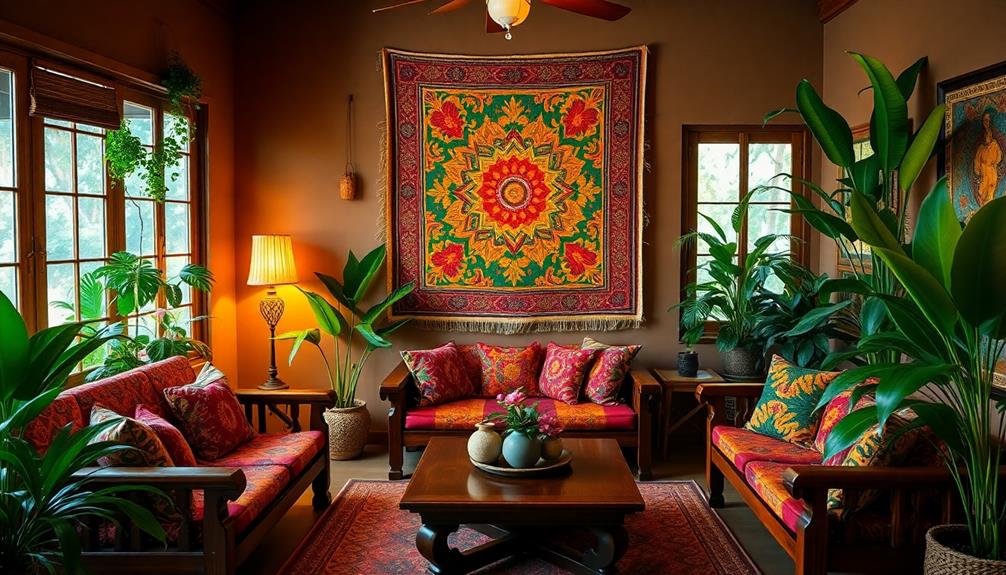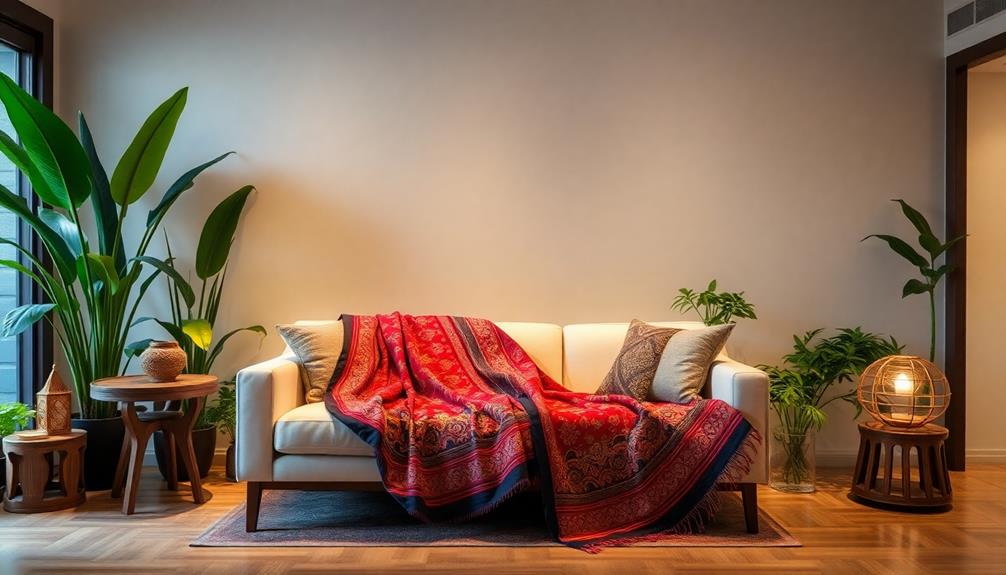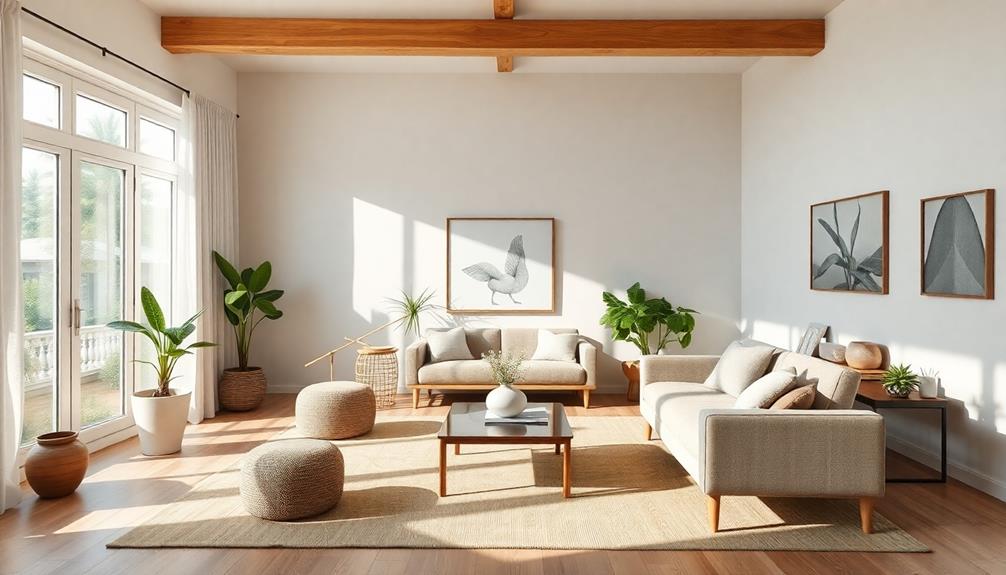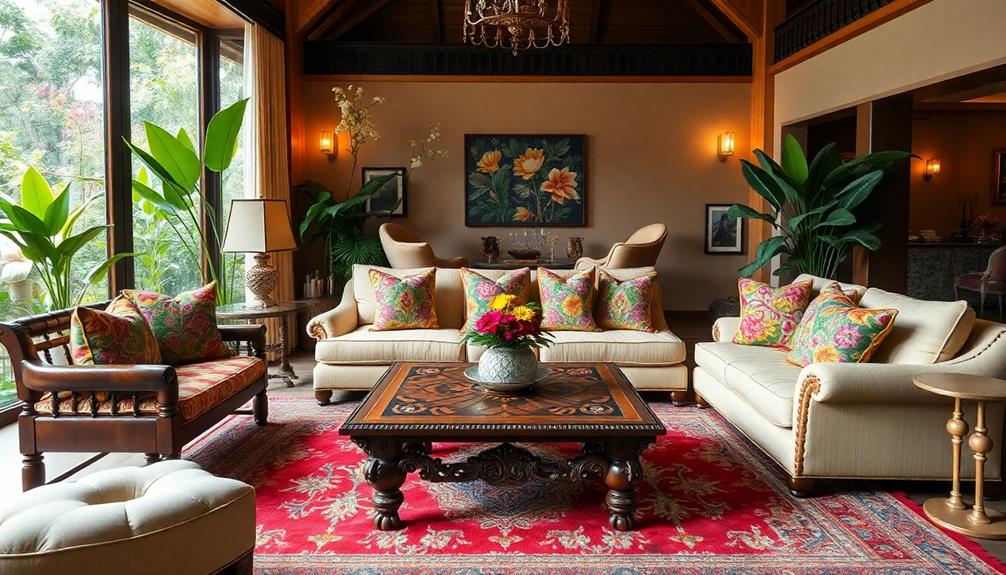You can use batik to add vibrant character and depth to your home effortlessly. Incorporate batik through textiles like throw pillows, table runners, and curtains to create bold focal points. Frame batik fabric as wall art for a stunning gallery display. For functional decor, use batik on lampshades or storage bins to enhance style while staying organized. Choose colors and patterns that complement your existing decor for a cohesive look. Mixing traditional designs with contemporary accents can elevate any space. If you're curious about more creative ways to integrate batik into your decor, there's much more to explore!
Key Takeaways
- Incorporate batik textiles in throw pillows, table runners, and curtains to create bold focal points in your home decor.
- Frame batik fabric as wall art to add vibrant color and cultural significance to your living space.
- Use batik in functional decor items like lampshades and storage bins to enhance organization with artistic flair.
- Mix and match batik patterns and solid colors in cushions to achieve visual balance and depth in seating arrangements.
- Engage in DIY projects by creating wall art or table settings with batik, allowing for personal expression in your home decor.
What Is Batik?

Batik is a vibrant fabric art form that captivates with its intricate patterns and rich history. Originating in Java, Indonesia, batik employs a wax-resist dyeing technique that creates complex designs on fabric. This method guarantees that each piece is unique, as no two items are identical due to the hand-dyeing process.
The artistry involved in batik gives it a distinctive charm and artisanal quality, making it a sought-after choice for home decor. Additionally, batik shares a similar cultural significance to other Indonesian handicrafts, such as the Face Indonesian Decor Mask, which represents rich cultural heritage through its intricate designs and vibrant colors.
Incorporating batik into your living space can add character and depth. You can use batik fabrics for curtains, pillow covers, or even wall hangings, allowing the intricate patterns to serve as focal points in your interior design.
The versatility of batik means you can find styles ranging from traditional motifs to modern interpretations, guaranteeing that it complements your existing decor. Whether you choose bold colors or subtle designs, batik can transform a room, infusing it with personality and warmth.
History and Cultural Significance

The rich history of batik reveals its deep cultural roots and significance, particularly in Indonesia where it's celebrated as a vital part of national identity. Originating from Java, batik has been recognized by UNESCO as a Masterpiece of Oral and Intangible Heritage, emphasizing its artistry and cultural value. This technique dates back over 2,000 years, with historical artifacts found in regions like Central Asia and East Asia, showcasing its long-standing tradition.
Each batik piece is unique, thanks to the hand-dyeing process that incorporates cultural symbolism and reflects the artisan's personal expression. You'll find a little bit of storytelling in Hmong batik, where geometric designs convey cultural narratives, underscoring the importance of preserving this artistry.
However, the production of batik is labor-intensive and faces challenges from modernization. As traditional craftsmanship wanes, there's a risk of losing this cultural identity.
Unique Characteristics of Batik
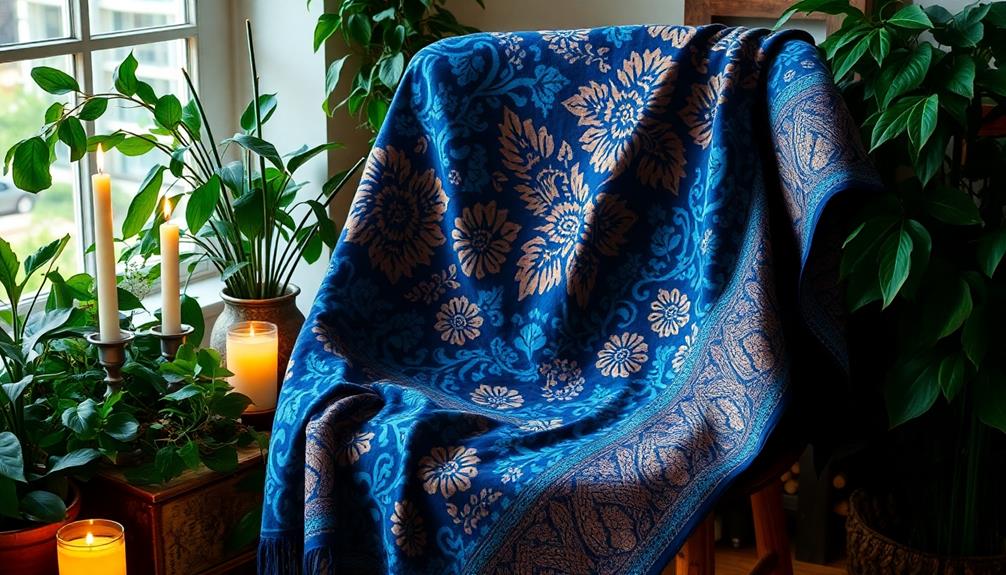
With its mesmerizing hand-dyeing process, batik stands out for its vibrant patterns and rich textures. You'll appreciate that each piece is unique because hot wax is applied to the fabric in a way that creates distinct designs resistant to dye. No two strokes of wax are identical, so every batik item showcases variations in color and pattern, reflecting the artisanal nature of the craft.
Like traditional artistry in Indonesian decor masks, batik also conveys a deep connection to local culture and storytelling.
Batik draws inspiration from natural elements, allowing it to feature vivid hues that resonate with cultural and historical significance. As the fabric dries, an oxidation process occurs, further enhancing the distinctive look of each piece. This adds depth and character that you won't find in mass-produced textiles.
Moreover, batik often incorporates symbolic designs and cultural motifs, connecting the fabric to its historical roots. When you use batik in your home decor, you're not just adding a beautiful piece; you're inviting a story and a rich tradition into your space.
Whether it's a wall hanging or cushion cover, batik's unique characteristics make it a meaningful addition that elevates your interior design.
The Batik Creation Process

Artisans begin the batik creation process by applying hot wax to fabric, intricately crafting designs with tools like brushes or the traditional tjanting. This wax acts as a resist, preventing dye from penetrating those areas, allowing the original color of the fabric to shine through. The use of vibrant colors and intricate patterns not only enhances the fabric but also reflects the rich cultural heritage of Indonesia, making it a stunning element in interior design.
After applying the wax, the fabric is immersed in dye baths, where the un-waxed sections absorb color. The result is a striking contrast, showcasing the detailed patterns once the dyeing is complete.
To achieve more complexity and vibrancy, artisans often use multiple dye baths. Each bath can introduce different colors, enhancing the overall depth and variety of the design. Once dyeing is finished, the wax is removed, typically using hot water. This step reveals the unique patterns that were preserved during the dyeing process, each piece telling its own story.
The entire batik creation process highlights the handcrafted nature of this fabric art. No two pieces are alike, reflecting the artisan's individual touch and creativity. This uniqueness is what makes batik not just a textile but a cherished work of art, perfect for adding character to your home.
Incorporating batik elements can also complement other Indonesian decorative items, such as Indonesian decorative pillows, enhancing the overall aesthetic of your living space.
Incorporating Batik Into Home Decor
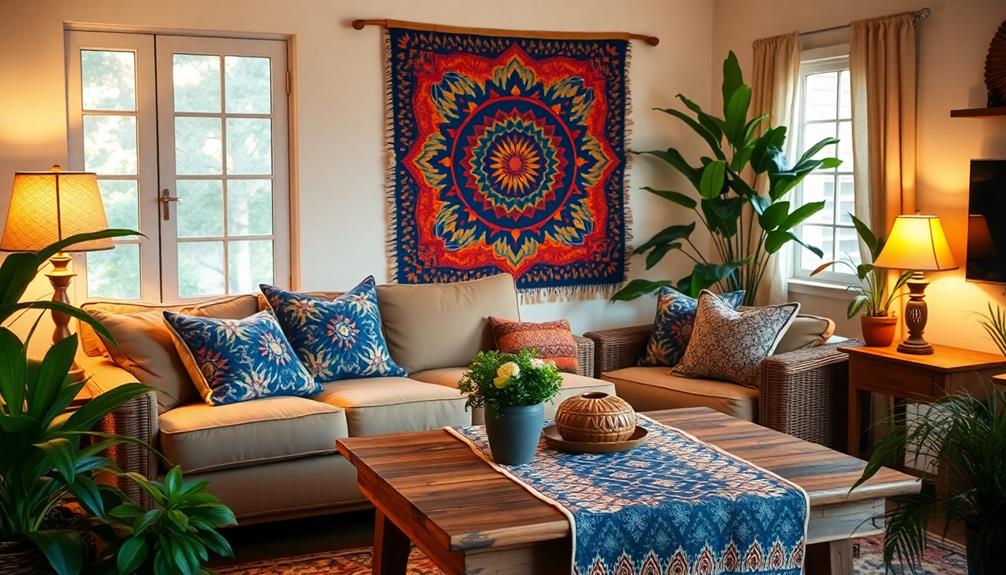
Batik's unique beauty makes it an ideal choice for enhancing your home decor. You can easily incorporate this vibrant fabric in various ways to create a rich, culturally infused atmosphere. For instance, consider using batik table runners or placemats to elevate your dining settings. They not only add a unique touch but also blend artistry with everyday functionality, making every meal a special occasion.
Additionally, batik's intricate designs often reflect local myths and folklore, similar to the way Indonesian decor masks serve as cultural storytelling pieces, enhancing the depth of your decor.
Another great option is to use batik as wall art. Framing batik pieces or creating a gallery wall with them showcases the intricate designs and craftsmanship, transforming any space into an artistic haven.
You can also introduce batik-covered lampshades or DIY curtains to bring striking colors and patterns into your rooms, enhancing the overall ambiance.
Don't overlook the practical side of batik either. Crafting storage solutions like batik-covered bins or boxes not only helps with organization but also serves as decorative elements that reflect your appreciation for cultural heritage.
Batik Accent Pillows
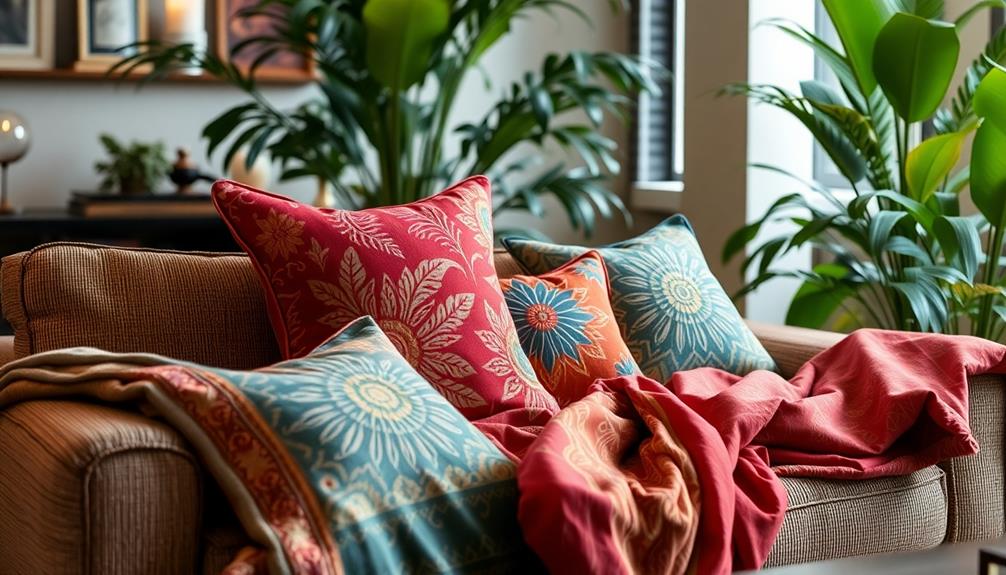
Batik accent pillows bring unique patterns and textures that can transform your space.
By incorporating traditional Balinese motifs, you can further enhance the aesthetic appeal of your home.
To create a cohesive look, you'll want to coordinate colors with your existing decor while mixing styles for an eclectic vibe.
Don't forget to play with different shapes and sizes to enhance the inviting nature of your seating arrangements.
Unique Patterns and Textures
With their intricate designs and vibrant colors, batik accent pillows bring a unique flair to your home decor. Each pillow showcases unique patterns, reflecting the handcrafted nature of batik, so you can be sure that no two pieces are identical. This individuality adds an element of charm and authenticity to your living space, much like the traditional Indonesian style home decor that emphasizes harmony and cultural significance.
The rich colors and designs inspired by natural elements can enhance the visual interest of any room, making your decor more dynamic. By incorporating batik pillows, you can effortlessly mix traditional fabrics with contemporary styles, creating a harmonious blend of cultures that tells a story.
These accent pillows serve as striking focal points, drawing attention and sparking conversation due to their artistic significance and cultural heritage. You'll find that their versatility in design allows for various shapes and sizes, making it easy to complement different furniture arrangements while adding depth to your decor.
Whether you place them on your sofa, bed, or chairs, batik accent pillows infuse your space with character, turning your home into a vibrant expression of your style.
Color Coordination Tips
When choosing batik accent pillows, it's important to blend them seamlessly with your existing decor. Start by selecting colors that complement your current color scheme; batik patterns often boast vibrant hues inspired by nature, making them versatile for various settings.
To create a balanced look, mix batik pillows with solid-colored cushions. The intricate designs of batik can serve as a focal point, while the solid pillows provide visual rest. You might also consider incorporating traditional batik patterns from Indonesian culture to enhance the uniqueness of your decor.
Don't hesitate to experiment with different batik patterns and shapes, such as square and round pillows. This adds layers and depth to your seating area, enhancing the overall aesthetic.
Batik accent pillows also introduce cultural elements into your home, as each piece tells a unique story through its craftsmanship and colors.
Consider rotating your batik pillows seasonally to refresh your space. This allows you to easily incorporate different color palettes and styles that align with changing decor themes.
Mixing Styles Effectively
Mixing styles effectively can transform your living space into a vibrant tapestry of colors and textures.
Batik accent pillows are a fantastic way to introduce rich colors and intricate patterns that reflect cultural heritage, showcasing the beauty of Southeast Asia Decor. When you pair these pillows with solid or traditional fabrics, you enhance visual interest and prevent your decor from feeling overly uniform.
Here are three tips to mix batik pillows seamlessly into your home:
- Combine Patterns: Mix batik designs featuring geometric patterns with floral or abstract shapes for a harmonious yet diverse look.
- Vary Sizes and Shapes: Use a mix of square, rectangular, and bolster pillows to add depth and layers to your seating areas, making them more inviting.
- Rotate Seasonally: Change your batik pillows with the seasons or for special occasions to refresh your decor, allowing for creative expression without a complete redesign.
Batik Wall Art Ideas
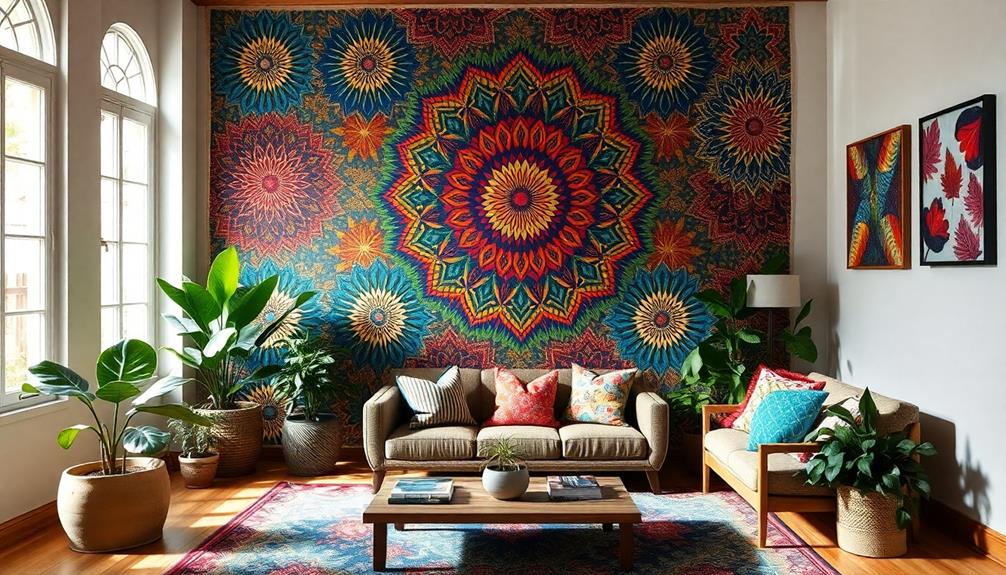
You can transform your walls with framed batik fabric displays that highlight the intricate designs and vibrant colors. Incorporating traditional elements like batik not only adds a cultural touch to your home but also aligns with the use of local materials that promote sustainability in traditional Indonesian housing.
Consider creating a gallery wall by mixing different batik patterns and colors to reflect your personal style. This not only adds depth to your decor but also makes for an eye-catching focal point in any room.
Framed Batik Fabric Displays
Framed batik fabric displays can transform your walls into a vibrant gallery of color and culture.
These stunning pieces not only showcase intricate designs but also reflect the handcrafted nature of batik art. By incorporating framed batik into your home, you can elevate your decor and invite conversation.
Additionally, integrating batik with sustainable craftsmanship in Balinese furniture can create a harmonious and culturally rich environment.
Here are three ideas for creating engaging batik displays:
- Mix and Match: Use a variety of batik patterns and sizes in your frames. This dynamic combination adds visual interest and depth to your space.
- Choose Simple Frames: Opt for frames that complement the colors and patterns of the batik. This approach guarantees the artwork remains the focal point without overwhelming your existing decor.
- Add Cultural Context: Pair your framed batik with descriptions or stories about their origin and meaning. This enhances appreciation for the art and its cultural significance.
Feel free to experiment by layering your framed batik with mirrors or photographs. This creates a cohesive and stylish focal point, making your space feel even more inviting and unique.
Gallery Wall Combinations
Creating an enchanting gallery wall with batik art can infuse your space with vibrant culture and personality. Start by combining various sizes and styles of batik fabric pieces. This dynamic arrangement showcases the unique artistry of each design, drawing the eye and sparking conversation. Frame small sections of batik fabric in contrasting frames to highlight their intricate patterns and colors, adding depth and visual interest.
To enhance the cultural richness of your display, mix different batik patterns, like traditional Hmong designs or Indonesian motifs. This variety tells a story while celebrating diverse artistic expressions. Make certain to arrange your batik art within a cohesive color scheme, using color theory principles to guarantee that the pieces complement each other beautifully.
Incorporating other types of wall art or decor, such as photographs or paintings, can create a layered and eclectic gallery wall that reflects your personal style. This fusion of batik and other art forms allows you to express your individuality while enjoying the enchanting charm of batik textiles.
With thoughtful arrangements, your gallery wall can become a stunning focal point in your home.
Using Batik in Textiles
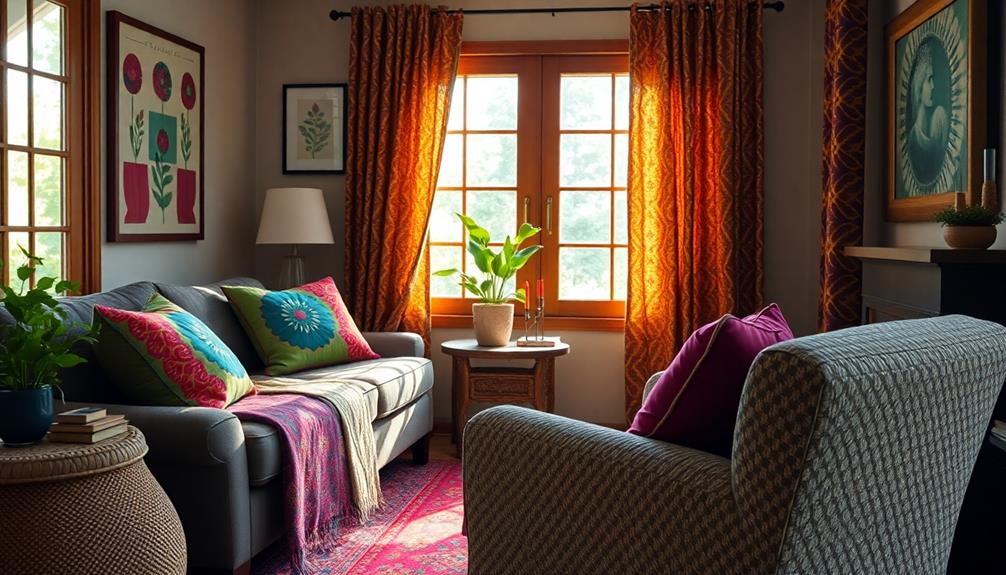
Batik textiles can transform your home decor by adding vibrant colors and intricate patterns that reflect cultural artistry. By incorporating batik into your textiles, you create stunning focal points that enhance your living spaces.
Here are three easy ways to use batik in your home:
- Throw Pillows: Adding batik fabric to your throw pillows can make eye-catching accents in your living room or bedroom. Mix different shapes and sizes for dynamic visual appeal.
- Table Runners and Placemats: Enhance your dining experience with batik table runners and placemats. These unique designs introduce cultural artistry, elevating the aesthetics of both casual and formal occasions.
- Curtains and Window Treatments: Utilize batik fabric for curtains to create bold focal points. Layering different textures and patterns will enrich your overall decor, bringing depth and character to your space.
DIY Batik Projects
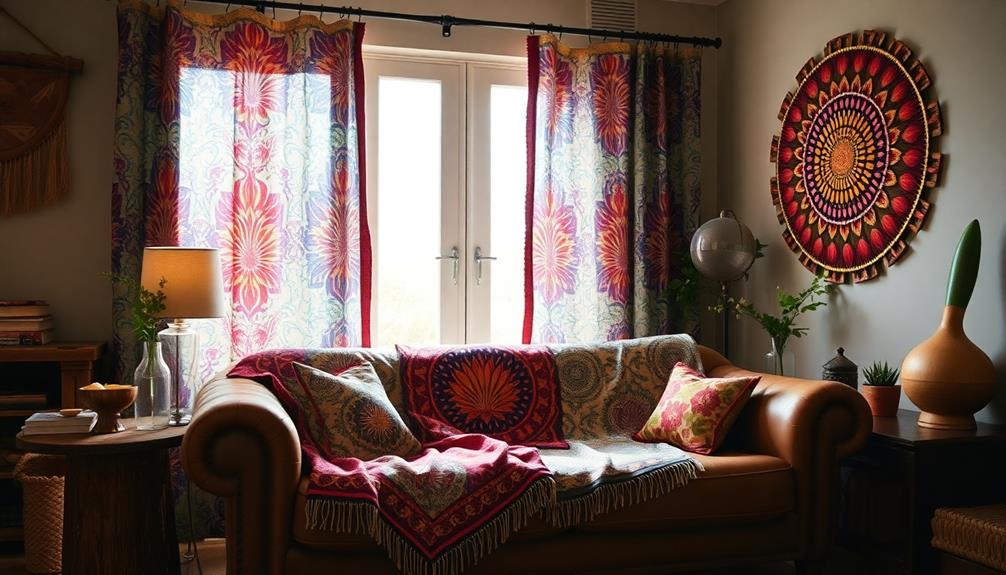
You can transform your space with DIY batik projects that add a personal touch.
Consider framing batik fabric for unique wall art or creating a batik table setting that impresses your guests.
These projects not only showcase your creativity but also enhance the vibrant atmosphere of your home.
Batik Wall Art Ideas
Transforming your walls with batik art offers a vibrant way to express your personality and style.
Batik's intricate designs can create stunning focal points in your home. Here are three DIY wall art ideas to inspire you:
- Framed Batik Panels: Frame small pieces of batik fabric to showcase their unique patterns. Hang them individually or in a group to create a fascinating display.
- Gallery Wall: Combine different batik patterns and colors to form a gallery wall. This enhances visual interest and lets you celebrate the diversity of this traditional art form.
- Batik Tapestries: Use fabric remnants to craft unique tapestries or wall hangings. These can add texture and cultural significance to your interior design while allowing for personal customization based on your color scheme and theme.
For a sturdy presentation, consider using canvas or wooden boards as a base for your batik pieces.
This not only provides stability but also complements various home decor styles. Embrace your creativity and let batik wall art bring character and depth to your space!
Batik Table Decor Tips
There's something special about incorporating batik into your table decor that instantly elevates any dining experience. Start by adding a vibrant batik table runner to introduce eye-catching colors and intricate patterns. This simple addition enhances the visual appeal of your dining setting.
Next, consider using batik napkins or placemats. They not only unify your decor but also bring a touch of cultural artistry to the table.
For a more eclectic vibe, mix and match different batik designs in your dinnerware setup. This approach showcases your personal style and makes your table display lively and inviting.
Don't forget about batik coasters! They complement your decor while protecting your surfaces from spills and heat, merging functionality with artistic flair.
For a stunning centerpiece, arrange batik fabric-wrapped vases or bowls. Customize these according to seasonal themes or color schemes, making sure they harmonize with the rest of your setup.
Tips for Choosing Batik Fabrics
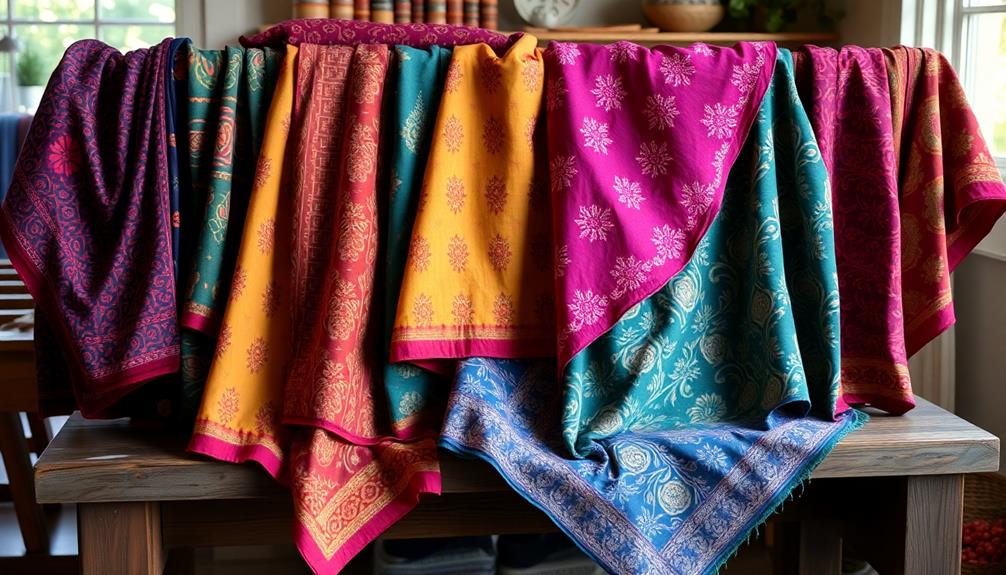
When choosing batik fabrics, it's essential to take into account their origin and cultural significance, as each piece tells a story rooted in tradition. Fabrics from Indonesia, for example, are renowned for their intricate designs and traditional craftsmanship.
Here are some tips to help you select the perfect batik fabric for your home:
- Consider Color Combinations: Look for unique colors inspired by nature. Each batik piece is distinct and often reflects the artisan's creativity and cultural heritage.
- Assess Weight and Texture: Verify the fabric suits your intended use. Lighter fabrics work well for curtains, while heavier options are ideal for cushions or upholstery.
- Choose Complementary Patterns: Opt for designs that fit your existing decor. Geometric patterns, common in Hmong batik, can create a striking contrast against more organic shapes in contemporary interiors.
Additionally, evaluate the quality of dye and waxing processes. Authentic batik should feature vibrant colors that resist fading and crisp wax lines, showcasing the artisan's skill.
With these tips, you can confidently choose batik fabrics that enhance your home's aesthetic.
Frequently Asked Questions
Can I Do Batik at Home?
Yes, you can definitely do batik at home! Gather some old sheets, RIT dye, and paraffin wax. Experiment with mason jars for dye baths, and enjoy the creative process while ensuring proper ventilation for safety.
How to Do Batik Technique?
Imagine a canvas waiting for your touch. You'll stretch the fabric, apply hot wax with a tool, dye it, and soak it to reveal intricate patterns, transforming simple cloth into a stunning work of art.
What Are the 5 Major Types of Batik Design?
You'll discover five major types of batik design: Javanese, Hmong, batik tulis, batik cap, and modern batik. Each type showcases unique patterns, techniques, and cultural significance, enriching your understanding of this beautiful art form.
What Is the Batik Crackle Effect?
Did you know the crackle effect can vary considerably based on wax thickness? This unique batik technique results from uneven cooling, creating distinctive patterns as dye seeps into the fissures, making each piece truly one-of-a-kind.
Conclusion
Incorporating batik into your home decor is like weaving a tapestry of history and artistry, where each piece tells its own story. Whether you hang stunning wall art or drape vibrant textiles, you're not just decorating; you're inviting a world of culture into your space. So, go ahead and let your walls and furnishings echo the rich traditions of batik, transforming your home into a canvas that celebrates creativity and heritage with every detail.

